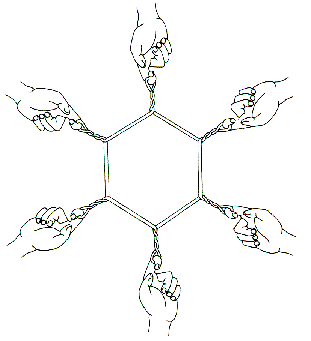This is a string loop illusion which fools an audience into thinking that the ends of a string loop have mysteriously passed through and locked one another. The illusion is continued by unlocking the loops.

'Apache Door' is widely known among Indians of the American Southwest. To some it represents a tent flap (an ornamented bison skin) -- hence the name. To others it represents a poncho, a flat stone for grinding corn into meal, or a netted-shield carried by their War God. It's a marvelous string figure which does not collapse no matter how hard it is pulled. Here is a more elaborate version of that figure.

James Hornell, known for his many string figure collections, obtained this figure in 1928 while touring Sierra Leone. This figure is widely distributed throughout Africa, being one of its most characteristic designs. In Sierra Leone it is known as "Fishing Net" or "Hammock"; in Liberia as "Fence"; in Nigeria as "Parrot Cage"; and in the Sudan as "Stringed-Bed".

'A Slip Trick' was inspired by many similar tricks found around the world. The object here is to first confuse the viewer with many rapid hand movements which seem to hopelessly entangle fingers and string. One then releases key loops, tugs on the string, and the hand slips free!

In a string figure series a continuous transformation takes place as the player concatenates two or more designs. There are four string figures in this series -- a working Scissors, a Broom, a Palm Tree, and a Banana you can peel. My series is based on a traditional Japanese three-figure series called the Hoki cycle. Here, I've eliminated the last figure and added my own ending. In addition to a loop of string, you'll need a pencil.

What you see as meaningful in a string figure depends on what experiences you have had. Although natives refer to the figure as a pot, this string figure reminds me of a benzene ring, with its carbon atoms bound in a hexagon and tipped with hydrogen atoms. Six hands (at least three people) are needed to make this very easy string figure.
